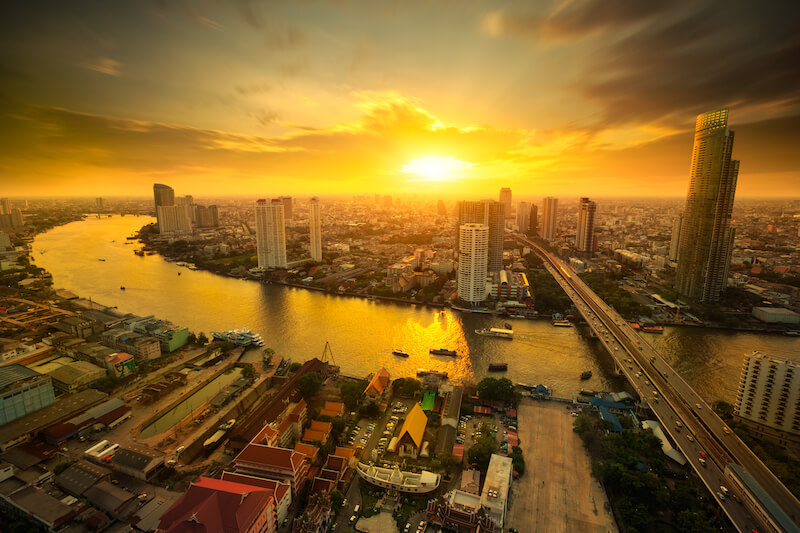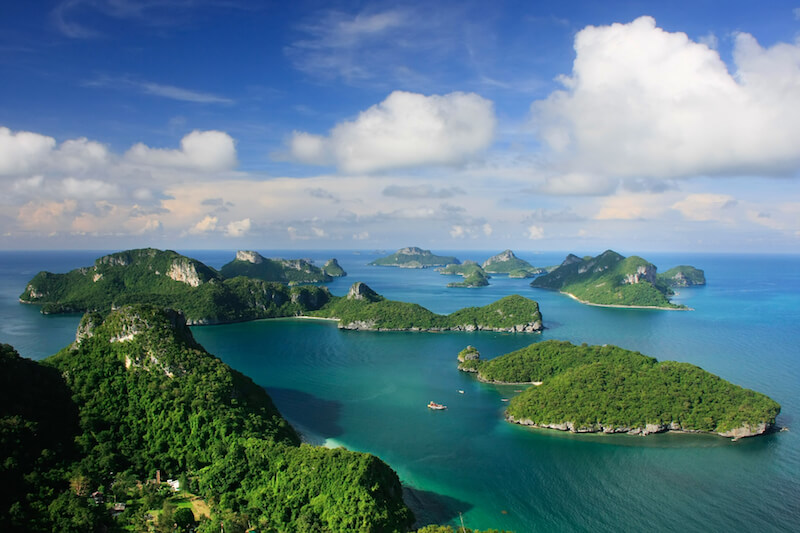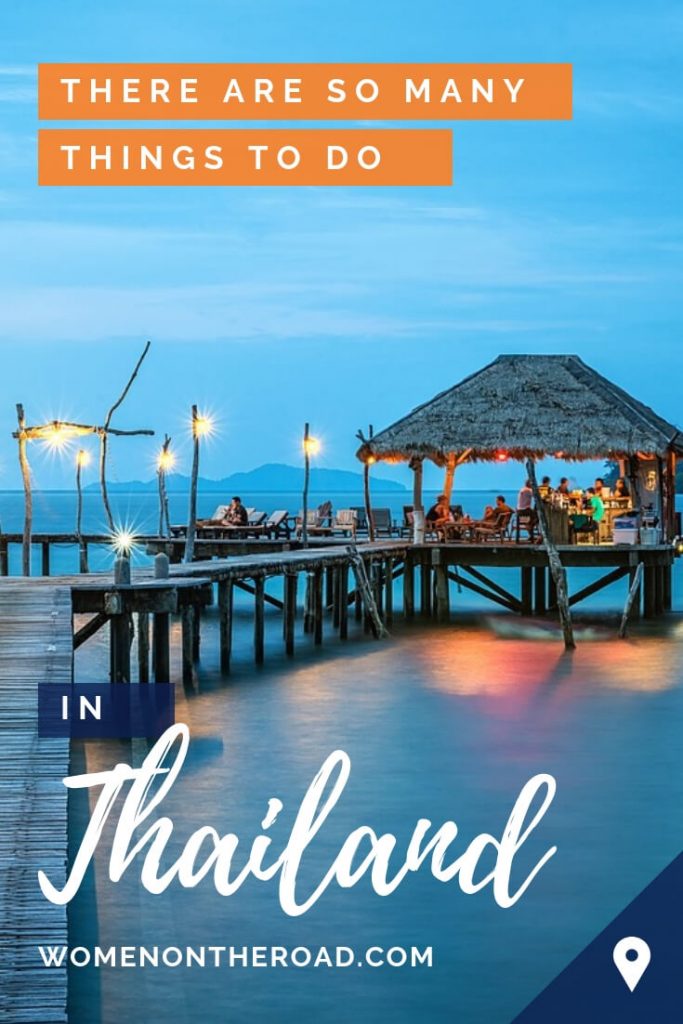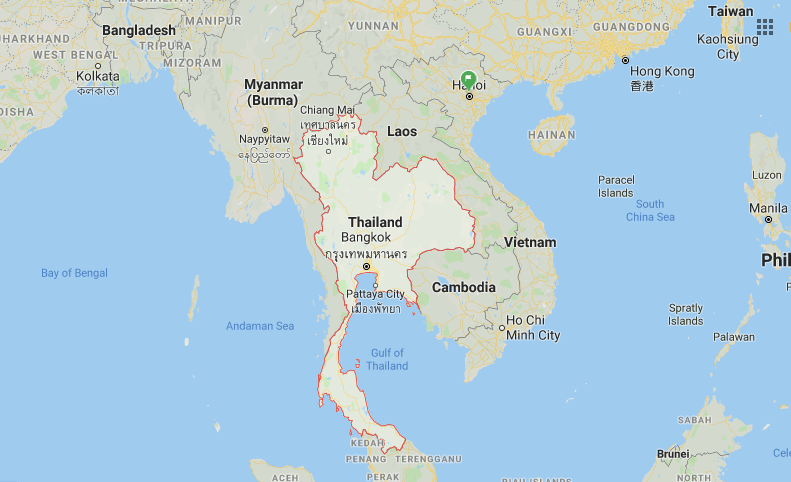If you’re planning a trip to Thailand for the first time, the incredible array of choices might feel overwhelming.
It doesn’t have to be – but you’ll have to accept one thing: you will not be able to see it all on your Thailand holiday!
If you can accept that one limitation, get ready to discover a place of centuries-old traditions with Indian influences and Chinese customs, where world-renowned street food bursts from night markets, and where powder-white sand, crystal clear waters flanked by milkwood trees and ocean views are standard.
First time in Thailand?
On a map, Thailand is bordered by the Gulf of Thailand, Myanmar to the north and west, Cambodia and Laos to the east and Malaysia to the south.
In terms of land area, the country covers just 513km2 – it’s a bit larger than California but smaller than Texas, so there’s a vastness to the 76 provinces that make up this enchanted Indian Ocean archipelago.
Best places in Thailand
A first trip to Thailand can be confusing, because there’s so much to see. Some of you will want to trek in the northern highlands, others will come for some of the world-renowed Thailand beach resorts or to sample the delectable street foods of Bangkok and beyond, and yet others will head for one of Bangkok’s world-class hospitals for medical tourism.
Thailand’s capital, Bangkok
The multicultural capital city of Bangkok is the largest and most developed city in the country. With a population of 12 million, expect crowds as the city also has Thailand’s largest airport.
It can overwhelm – if you’re unaccustomed to mega-cities. They say it takes at least two weeks to become accustomed to Bangkok’s speed, energy and pollution. Chances are you won’t be there that long so just be patient and understanding with all the buzz, and enjoy everything else. Even if you don’t take to big cities, know that you’re experiencing something unique.
The good news is that Bangkok is large enough to accommodate everyone who wants to visit. You’ll rarely find a place or neighborhood impassable, and even the most frequented eatery will find you a place to sit when you’re hungry. And if you are concerned about safety, be sure that Bangkok is safe for travelers.
A wonderful way to see Bangkok for the first time is along its backbone – the Chao Phraya River, with its markets, riverside houses and clutter of attractions. Float past Rattanakosin Island, the Grand Palace and the sacred Emerald Buddha temple and get off here and there, enjoying the freedom you’ll have along the river.


Sail to the end of the line and as you step onto land, you’ll be welcomed by the neon lights of the vibrant city and street side shopping along Khao San Road in Banglamphu — buy handmade clothing and accessories, and get a feel for what the area used to be like when it was ‘backpacker central’, the first stop along everyone’s Southeast Asia trip.
Not far from Bangkok
An hour out of Bangkok is the ancient city of Ayutthaya, which was founded in the 14th century and was the country’s capital for 417 years.
Thailand has five UNESCO World Heritage sites which include the Phra Nakhon Si Ayutthaya Historical Park and its three royal residences and temple ruins.
Spend the day visiting temple ruins and don’t miss the stone Buddha head that’s entwined in tree roots at Wat Mahathat. The walkways of Ayutthaya Floating Market will lead you around the water where you can buy delicious delicacies and keepsakes from the swaying wooden boats. Nearby you can also visit Bang Pa-In Palace, summer home of King Mongkut of The King and I fame.

The Golden Triangle
Known as The Golden Triangle, where the Mekong and Ruak Rivers is an area that forms a natural border between Thailand, Myanmar and Laos.
The area received its nickname from the CIA: it was once a major source of opium and heroin during the 1950s. In the early 21st century, Afghanistan took over as the world’s largest producer but illegal cultivation continues.
When you visit Northern Thailand, you’ll be surrounded by green tropical forests and a mountainous landscape.
The region’s largest and most popular city is Chiang Mai, where you’ll find the country’s highest peak, the 2565-meter-high Doi Inthanon, and the cloud-crowned, sacred twin peaks of Doi Suthep and Doi Pui. Worth seeing in Chiang Mai is the stunning Wat Phra Singh temple, which translates monastery of the Lion Buddha, while the Wat Chedi Luang temple is adorned with carved serpents.
Otherwise, Chiang Mai is a Thai city with all the trappings – night markets, silk shopping and plenty of temples.

With its large expat community, Chiang Mai is affordable for new digital nomads and has constant networking opportunities, meetups and social outings. There are plenty of hiking possibilities and the north is a great destination for nature lovers, with over 3000 flowers and fern species and more than 200 bird species.
Chiang Rai is a smaller alternative to Chiang Mai and the provinces are 3-4 hours apart by bus. Chiang Rai is dotted with ancient temples, the most popular being the King Mengrai Monument – in honor of the man who founded this 13th-century city – and Wat Rong Khun, better known as the White Temple.
While visiting the Golden Triangle, you can take a boat ride through what used to be prime opium farmland; there are also hilltribe villages but be careful when you choose your tour. Some hilltribes have been commercialized to a dangerous extent, their traditions endangered and their homes turned into zoos. Please make the effort to find responsible tours that include the community in their management and activities.
Thailand’s shores and islands
A key reason many visit Thailand is for… the sea. The country has enough beachfront to satisfy everyone, whether on the mainland’s coast or on any of the nearly 1500 islands (called koh) that dot its coastlines.
From diving to relaxing, there is a koh for everyone. The largest, Phuket (pronounced ‘poo-ket’) is the pearl of the Andaman Sea. Although it was ravaged by a tsunami in 2004, you wouldn’t know it today. It is easily accessible by bus, train or plane and is known for the best beaches in the country, with bays bathed in azure blue waters, shaded by palms and looking towards an island-studded sea.
Located on the east coast, the popular Koh Samui is one of the most upmarket of Thailand’s islands. See Wat Phra Yai, the tall statue of Buddha in a seated position. Go for a swim at Chaweng Beach with affordable food and drinks or Lamai Beach, slightly more expensive but with fewer crowds. Visit Samui Butterfly Garden in the south or go trekking in the western highlands. And finally, don’t leave before visiting the emerald islands of Muko Angthong National Marine Park.

If you’re a water sports fanatic, Krabi is the place to visit for kayaking, rafting, snorkeling and or diving. Visit Susan Hoi, the ancient shell cemetery that dates back more than 40 million years. Learn about the importance of not riding elephants at the Krabi Elephant Sanctuary. Admire art at the Krabi Contemporary Art Museum. Soak in hot springs in Namtok Ron Khlong Thom. Climb 1,237 stairs to reach Wat Tham Suea (Tiger Cave Temple).
While in the province of Krabi, visit Koh Phi Phi. You can tour Monkey Beach but not the famous Maya Beach, where The Beach was filmed, shut down because of overtourism.
Get breathtaking views of Hua Hin, a coastal Thai family resort, from the feet of the gigantic standing Buddha sculpture at Khao Takiab. King Rama VII built his Klai Kangwon Summer Palace here. Indulge in seafood at one of the many beachfront restaurants, or try the night market for a taste of local cuisine.
What to eat in Thailand

You’ll never go hungry in this country, whatever your dietary requirements.
Thai food is delicately fragrant, light and healthy and there are restaurants and food trucks everywhere.
Thai meals usually have four to five courses. Starters are usually soups, followed by a salad, a fried dish, then curry and desserts – like the popular mango sticky rice and crispy pancakes (khanom buang).
There are plenty of regional specialties, like green papaya salad from the northeast, massaman (Muslim) curry (made with potatoes from the south) and pad thai in central Thailand.
Spicy food tolerance differs from person to person and most restaurants that serve a lot of tourists don’t serve spicy food. It’s important to ask for food that’s prik (spicy) or mai pet (not spicy) when placing an order. You CAN actually have an entire non-spicy meal in this country!
And keep in mind that tipping in Thailand isn’t mandatory, but always appreciated.
Is Thailand safe for solo women?
According to the Geosure app, Thailand is moderately safe.
Intentional homicide of women, non-intimate partner violence and legal discrimination are low. You can mostly walk alone at night (within logical limits), but beware of child pickpockets and fake baht scams. Try to pay in the exact bills to avoid counterfeit change.
To avoid overcharging by taxis, motorbikes and tuk-tuks, download the Grab app (Southeast Asia’s version of Uber) and pay by card.
In the past decade, the tourism industry has changed with the increase of backpackers, digital nomads and work and trade opportunities. This increase has led to a heftier police presence in popular tourist areas.
Whereas Thailand was long known as a sex tourism destination, the government worked hard to change that perception in an effort to attract a different type of visitor. Police also intensified their bar raids in an effort to stamp out human trafficking and the drug trade. Today, the former sex haunts are still there but much diminished.
The government is also taking steps to change guidelines and policies on the issue of commercializing art and entertaining tourists through bastardized rituals, for commercial endeavours. Hotels are required to inform the ministry of international visitors. Visitors are also encouraged to carry identification at all times.
Best time to travel to Thailand
It depends on your type of holiday…
- From March to June, the weather is hot and humid, which isn’t great for sightseeing but perfect for relaxing at the beach and enjoying water activities.
- June to October is monsoon season, which isn’t great for beachgoers because of the excessive rain and tides.
- October to February is the cool season in Thailand and the perfect time to visit the glorious green mountains, rice terraces and winter flowers. It’s also the perfect time for sightseeing because although it never gets cold, this season makes it bearable to be outdoors.
Sample Thailand itineraries
One week in Thailand and the North
Day 1-2: Explore Bangkok
Day 3: Kanchanaburi & Bridge over the River Kwai
Day 4: Ayutthaya
Day 5: Chiang Mai
Day 6: Chiang Rai
Day 7: Chiang Mai
A week in Thailand including the Thai Islands
Day 1-2: Explore Bangkok
Day 3-4: Chiang Mai
Day 5-7: Phuket and island-hopping
Thailand travel tips for first-timers
- There’s a reason Thai people have a reputation for being the friendliest in the world: it’s because they probably are. There always seems to be a forthcoming offer of help, even when there is a language barrier.
- Society genuinely accepts the LGBT community, everyone is treated equally and same-sex couples are common.
- Despite Thai people’s open mindedness and acceptance of western cultures, Thailand is still conservative. Showing respect to others is essential and it’s important to wai when greeting, refrain from showing public displays of affection, dress appropriately when visiting temples, remove your shoes when entering people’s homes, never raise your voice especially to elders and most importantly, never say anything negative about the King.
- Stock up on insect-repellent clothing, products and sunscreen as these are all extremely expensive in Thailand.
- Pack activated charcoal pills, used to relieve digestive issues and treat food poisoning.
- Keep in mind that Thailand is obsessed with skin complexion and most beauty properties sold here contain bleaching properties, to be safe it’s best to purchase baby products.
- Tourists from a range of countries do not need a visa to enter Thailand but citizens from a number of other countries – including some EU countries – will need to get either an eVisa for Thailand or a visa on arrival. Do make sure you check!
- Expensive hotels and luxury resorts no longer have the monopoly as they used to, but there are still plenty of them around. For the best Thailand hotel deals, check out booking.com.
SHOP THIS POST ON AMAZON
PIN THESE PICTURES AND SAVE FOR LATER!








